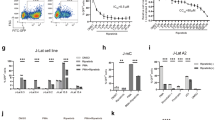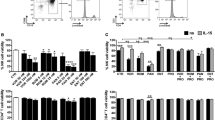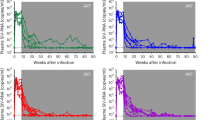Abstract
Despite antiretroviral therapy, proviral latency of human immunodeficiency virus type 1 (HIV-1) remains a principal obstacle to curing the infection1. Inducing the expression of latent genomes within resting CD4+ T cells is the primary strategy to clear this reservoir2,3. Although histone deacetylase inhibitors such as suberoylanilide hydroxamic acid (also known as vorinostat, VOR) can disrupt HIV-1 latency in vitro4,5,6, the utility of this approach has never been directly proven in a translational clinical study of HIV-infected patients. Here we isolated the circulating resting CD4+ T cells of patients in whom viraemia was fully suppressed by antiretroviral therapy, and directly studied the effect of VOR on this latent reservoir. In each of eight patients, a single dose of VOR increased both biomarkers of cellular acetylation, and simultaneously induced an increase in HIV RNA expression in resting CD4+ cells (mean increase, 4.8-fold). This demonstrates that a molecular mechanism known to enforce HIV latency can be therapeutically targeted in humans, provides proof-of-concept for histone deacetylase inhibitors as a therapeutic class, and defines a precise approach to test novel strategies to attack and eradicate latent HIV infection directly.
This is a preview of subscription content, access via your institution
Access options
Subscribe to this journal
Receive 51 print issues and online access
$199.00 per year
only $3.90 per issue
Buy this article
- Purchase on Springer Link
- Instant access to full article PDF
Prices may be subject to local taxes which are calculated during checkout



Similar content being viewed by others
References
Blankson, J. N., Persaud, D. & Siliciano, R. F. The challenge of viral reservoirs in HIV-1 infection. Annu. Rev. Med. 53, 557–593 (2002)
Margolis, D. M. Histone deacetylase inhibitors and HIV latency. Curr. Opin. HIV AIDS 6, 25–29 (2011)
Van. Lint, C. et al. Transcriptional activation and chromatin remodeling of the HIV-1 promoter in response to histone acetylation. EMBO J. 15, 1112–1120 (1996)
Archin, N. M. et al. Expression of latent human immunodeficiency type-1 is induced by novel and selective histone deacetylase inhibitors. AIDS 23, 1799–1806 (2009)
Archin, N. M. et al. Expression of latent HIV induced by the potent HDAC inhibitor suberoylanilide hydroxamic acid. AIDS Res. Hum. Retroviruses 25, 207–212 (2009)
Contreras, X. et al. Suberoylanilide hydroxamic acid reactivates HIV from latently infected cells. J. Biol. Chem. 284, 6782–6789 (2009)
Lehrman, G. et al. Depletion of latent HIV infection in vivo: a proof of concept study. Lancet 366, 549–555 (2005)
Archin, N. M. et al. Valproic acid without intensified antiviral therapy has limited impact on persistent HIV infection of resting CD4+ T cells. AIDS 22, 1131–1135 (2008)
Siliciano, J. D. et al. Stability of the latent reservoir for HIV-1 in patients receiving valproic acid. J. Infect. Dis. 195, 833–836 (2007)
Sagot-Lerolle, N. et al. Prolonged valproic acid treatment does not reduce the size of latent HIV reservoir. AIDS 22, 1125–1129 (2008)
Archin, N. M. et al. Antiretroviral intensification and valproic acid lack sustained effect on residual HIV-1 viremia or resting CD4+ cell infection. PLoS ONE 5, e9390 (2010)
Keedy, K. S. et al. A limited group of class I histone deacetylases act to repress human immunodeficiency virus type-1 expression. J. Virol. 83, 4749–4756 (2009)
Edelstein, L. C., Micheva-Viteva, S., Phelan, B. D. & Dougherty, J. P. Activation of latent HIV type 1 gene expression by suberoylanilide hydroxamic acid (SAHA), an HDAC inhibitor approved for use to treat cutaneous T cell lymphoma. AIDS Res. Hum. Retroviruses 25, 883–887 (2009)
Gui, C. Y. et al. Histone deacetylase (HDAC) inhibitor activation of p21WAF1 involves changes in promoter-associated proteins, including HDAC1. Proc. Natl Acad. Sci. USA 101, 1241–1246 (2004)
Du, L., Musson, D. G. & Wang, A. Q. High turbulence liquid chromatography online extraction and tandem mass spectrometry for the simultaneous determination of suberoylanilide hydroxamic acid and its two metabolites in human serum. Rapid Commun. Mass Spectrom. 19, 1779–1787 (2005)
Rubin, E. H. et al. A study to determine the effects of food and multiple dosing on the pharmacokinetics of vorinostat given orally to patients with advanced cancer. Clin. Cancer Res. 12, 7039–7045 (2006)
Hermankova, M. et al. Analysis of human immunodeficiency virus type 1 gene expression in latently infected resting CD4+ T lymphocytes in vivo. J. Virol. 77, 7383–7392 (2003)
Palmer, S. et al. New real-time reverse transcriptase-initiated PCR assay with single-copy sensitivity for human immunodeficiency virus type 1 RNA in plasma. J. Clin. Microbiol. 41, 4531–4536 (2003)
Lee, J. H., Choy, M. L., Ngo, L., Foster, S. S. & Marks, P. A. Histone deacetylase inhibitor induces DNA damage, which normal but not transformed cells can repair. Proc. Natl Acad. Sci. USA 107, 14639–14644 (2010)
Lee, J. H., Choy, M. L., Ngo, L., Venta-Perez, G. & Marks, P. A. Role of checkpoint kinase 1 (Chk1) in the mechanisms of resistance to histone deacetylase inhibitors. Proc. Natl Acad. Sci. USA 108, 19629–19634 (2011)
Israel-Ballard, K. et al. TaqMan RT-PCR and VERSANT HIV-1 RNA 3.0 (bDNA) assay quantification of HIV-1 RNA viral load in breast milk. J. Clin. Virol. 34, 253–256 (2005)
Robinson, L. H., Gale, C. V. & Kleim, J. P. Inclusion of full-length human immunodeficiency virus type 1 (HIV-1) gag sequences in viral recombinants applied to drug susceptibility phenotyping. J. Virol. Methods 104, 147–160 (2002)
Radonić, A. et al. Guideline to reference gene selection for quantitative real-time PCR. Biochem. Biophys. Res. Commun. 313, 856–862 (2004)
May, R. C. et al. Change-Point Models to Estimate the Limit of Detection (Working Paper 26, University of North Carolina at Chapel Hill Biostatistics Technical Report Series, March 2012); available at http://biostats.bepress.com/uncbiostat/papers/art26
Tonelli, R. et al. G1 cell-cycle arrest and apoptosis by histone deacetylase inhibition in MLL-AF9 acute myeloid leukemia cells is p21 dependent and MLL-AF9 independent. Leukemia 20, 1307–1310 (2006)
Acknowledgements
This study was supported by National Institutes of Health grants AI084553, AI095052 and AI096113, and by a grant from Merck & Co to D.M.M., National Institutes of Health grants RR024383 to the UNC TRaCS Institute, AI50410 to the UNC Center for AIDS Research, and an equipment grant from the James B. Pendleton Charitable Trust. Merck & Co provided VOR. The ClinicalTrials.gov identifier is NCT01319383. We thank N. P. Dahl, R. Sackmann, M. Cheema, A. Wiegand and N. White for technical support, Y. Park and the staff the UNC Blood Bank, R. J. Bedimo and C. M. van der Horst for study oversight, and J. Scepanski and A. Sugarbaker for patient follow-up and study coordination. We thank M. S. Cohen, J. V. Garcia-Martinez, W. C. Greene, J. Karn and R. F. Siliciano for discussions. Finally, we are grateful for the contributions of the patients who have participated in these studies.
Author information
Authors and Affiliations
Contributions
N.M.A., A.L.L., D.C.P., S.K.C., M.C.S., D.D.R., D.J.H. and D.M.M. designed and performed primary study assays and performed study analysis. J.D.K., A.M.C., J.J.E. and D.M.M. designed, implemented and oversaw the clinical protocol. M.G.H. and R.J.B. designed the data analysis. A.D.K. oversaw pharmacokinetic assays and analysed these data. M.F.K., E.M.A. and J.M.C. designed and performed single-copy assays.
Corresponding author
Ethics declarations
Competing interests
D.J.H. is an employee of Merck and Co., and J.J.E. and D.M.M. have received grants and consulting honoraria from Merck and Co. N.M.A., D.J.H. and D.M.M. are co-inventors of a patent for the use of vorinostat in HIV infection, but to lead this study D.M.M. has remanded ownership of this patent to UNC Chapel Hill.
Rights and permissions
About this article
Cite this article
Archin, N., Liberty, A., Kashuba, A. et al. Administration of vorinostat disrupts HIV-1 latency in patients on antiretroviral therapy. Nature 487, 482–485 (2012). https://doi.org/10.1038/nature11286
Received:
Accepted:
Published:
Issue Date:
DOI: https://doi.org/10.1038/nature11286
This article is cited by
-
Keep quiet: the HUSH complex in transcriptional silencing and disease
Nature Structural & Molecular Biology (2024)
-
Bispecific antibodies promote natural killer cell-mediated elimination of HIV-1 reservoir cells
Nature Immunology (2024)
-
Multimeric immunotherapeutic complexes activating natural killer cells towards HIV-1 cure
Journal of Translational Medicine (2023)
-
Decoding the ‘Fifth’ Nucleotide: Impact of RNA Pseudouridylation on Gene Expression and Human Disease
Molecular Biotechnology (2023)
-
Molecular mechanisms by which the HIV-1 latent reservoir is established and therapeutic strategies for its elimination
Archives of Virology (2023)
Comments
By submitting a comment you agree to abide by our Terms and Community Guidelines. If you find something abusive or that does not comply with our terms or guidelines please flag it as inappropriate.



